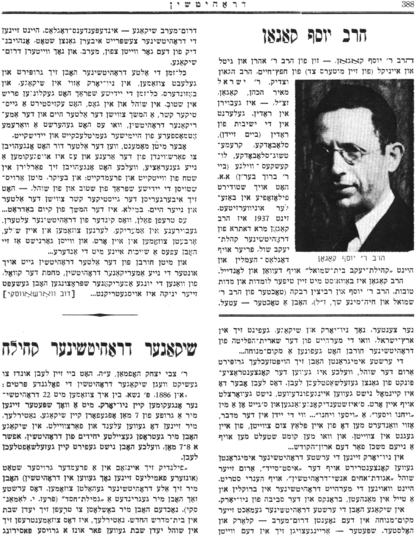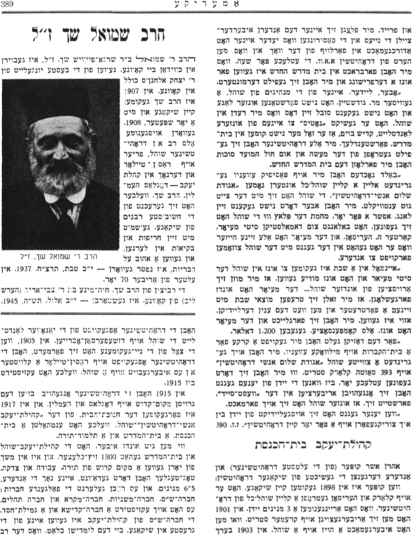
[Page 388]
Drohitchin émigrés is in Israel, where the majority of survivors of the Drohitchin Holocaust found a refuge.
The first emigrants lived mainly around the synagogue, which was the focal point of community life. However, life was never well-established or rooted just in one spot. There was always a tendency to settle down and then move elsewhere, like the Jews in the Desert with Moses. Thus, they wandered from one place to the next, from one area to another, and wherever they settled, they found a new sanctuary for the Holy Ark.
The first Drohitchin emigrants were concentrated on the East Side, around the Agudat Achim-Anshei Drohitchin [Brotherhood of People of Drohitchin] Synagogue on Henry Street. Today most of the Drohitchin community lives in Brooklyn, and some in Manhattan, the Bronx and in the New York City area. In Chicago, the first arrivals from Drohitchin found their refuge in the southwest section – Clark and Holster. Later on, they moved further into the southwest, to Independence and Douglas. Today they are spread out throughout the city, from the most northern section, the west and south.
As long as the old émigrés from Drohitchin lived together in New York and in Chicago, and especially as long as the Yiddish language was spoken at home, in the synagogue and on the street, there existed an emotional connection between the old country and the Drohitchin communities in the United States, where a warm atmosphere of good old-fashion comfort and Jewish life ruled the day.
Now, however, when the old generation has started leaving the scene, and a new generation has arisen who have begun to get lost through distance, territory and alienation, and especially with the demise of Yiddish in the home and synagogue, the emotional connection between the old country and the new has been broken, and continuity is in danger.
There are cases of children of Drohitchin émigrés, who are born in the United States and who attend the same schools, work together, and yet do not have the slightest idea of any connection between them. With the destruction of Drohitchin, the new American Drohitchin community is also disappearing because the source of the young Americans' nourishment has dried up. (Dov Warshavsky).
Rabbi Yosef Kagan
[Photo:] Rabbi Yosef Kagan
Rabbi Yosef Kagan, son of Rabbi Aharon and Gittel Kagan, and grandson (on his mother's side) of the great Jewish rabbi, Yisrael Meir Hakohen Kagan, was born in Radin, attended the yeshivas of Radin (under his grandfather), Slabodka, Kremenchuk-Slabodka, Lukeshes-Vilna (under Rabbi Baruch Ber Lebowitz) and others. He also studied philosophy at the University of Basel. Since 1937, Rabbi Kagan has been the leader of the Drohitchin community synagogue, Kehillat Yaakov, located previously at Douglas-Hemlin, and now at Devan and Londale. Rabbi Kagan is known for his deep scholarship and good character traits. He and his wife Rivka (daughter of Rabbi Shmuel and Chaya-Mina Shach) have one daughter, Ethel.
Chicago Drohitchin Community
The late R. Zvi Yitzchak Hoffman had sent us the following information about the Chicago Drohitchin community.
“In 1886 in the week of the Torah portion Nasah, twenty-two Drohitchin residents and I arrived in New York. One week later, in a group of seven men we left for Chicago. Of course we were lonely and in despair. In Chicago we met a few individuals from Drohitchin – around 7-8 men who had no community life.
“Feeling lonely in a large foreign city (our families were still in Drohitchin), we all stuck together. The first thing we established was a free loan fund headed by Lamansky. Afterwards, we decided to get together every Sabbath in the new House of Study. Of course this weekly meeting was an important event and gave us pleasure.

[Page 389]
We would tell each other the news and the events we went through during the week, and what we heard from Drohitchin. Those couple of hours that we met in the new House of Study made us feel better and cheered us up.
“Unfortunately, one of the heads of the synagogue, a certain Mr. Goodstein, could not understand our situation, and could not stand that we were talking in synagogue. He sent a notice to one of our members, Kaddish Baum, telling him not to come to the House of Study anymore. Of course all of us were affected by this event, and during the week of Sukkot we left the new House of Study.
“Soon thereafter we set up our own small synagogue on Pacific Avenue with the name of “Agudat Shalom Anshei Drohitchin.” The synagogue developed, and we could not remain there very long, maybe two years, because the location of the synagogue belonged to the mayor, Carter H. Harrison, and he sold all his properties, among them the synagogue.
“One Sabbath the mayor came to our synagogue and informed us that we had to move. He suggested that we meet on Saturday night with one of his representatives, and we could take care of the matter. So we did. We came to an agreement, and the mayor offered us $1,200 compensation.
“We used that money to buy land for a cemetery on Milwaukee Avenue. We also founded a second synagogue, “Agudat Shalom Anshei Drohitchin” at 393 South Clark Street, where we remained for several years until Jews in the area started moving to the West Side. Therefore, we closed the synagogue. When that neighborhood lost all its Jews I returned to Drohitchin for a couple of years. See p. 390.
Kehilath Yaakov Synagogue
Aharon Asher Cooper (one of the oldest people from Drohitchin) and other reported the following:
When Cooper arrived in Chicago in 1898, he encountered a small Drohitchin synagogue at Clark and Harrison where there were around thirty Jews. In 1901 they moved to Kramer Street, where they turned a house into a synagogue. In approximately 1903 the Drohitchin community bought a synagogue from Yanova community at Jefferson and O'Brien. In 1905, when the number of arrivals increased, the Drohitchin émigrés bought a church at Racine and Taylor and turned it into a synagogue, which existed until 1915.
In 1915 the Drohitchin community started building the large structure at Douglas and Hemlin, and in 1917 they held the dedication of the Kehillat Yaakov-Anshei Drohitchin synagogue, which contained a sanctuary, House of Study and a Talmud Torah school. From what we are told, the Kehillat Yaakov synagogue and House of Study had 1,800 seats, and for years was a place dedicated to Torah, service and charity. Five to six quorums of men attended prayer services there each day one after the other, and they had groups engaged in study of Talmud, Mishnah, Torah and a group involved in reciting psalms. There was also a burial society and a free loan fund. The Talmud Group of the synagogue was one of the largest in Chicago. Many scholarly Jews attended the lectures
[this article continues on page 390]
Rabbi Shmuel Shach
Rabbi Shmuel, son of R. Shraga Feivush Shach, was born in Khvidan near Kovno. He was one of the finest students in the yeshiva for married men under Rabbi Yitzchak Elchanan Spector in Kovno. In 1907 Rabbi Shach arrived in Chicago, and a year later he was appointed rabbi in the Drohitchin synagogue, previously at Racine and Taylor, and later at Douglas and Hemlin as the Kehillat Yaakov synagogue. Rabbi Shach, who was considered one of the major rabbis of Chicago, was famous for his sharp understanding and expertise in Talmud. He was loved by all, and died on December 16, 1937 at the age of over 70. His wife, Chaya-Mina, daughter of R. Zvi Aryeh (Hersh Lieb) of Kovno, died on August 21, 1945.
Previous Page |
Next Page
JewishGen, Inc. makes no representations regarding the accuracy of
the translation. The reader may wish to refer to the original material
for verification.
JewishGen is not responsible for inaccuracies or omissions in the original work and cannot rewrite or edit the text to correct inaccuracies and/or omissions.
Our mission is to produce a translation of the original work and we cannot verify the accuracy of statements or alter facts cited.
 Drogichin, Belarus
Drogichin, Belarus
 Yizkor Book Project
Yizkor Book Project
 JewishGen Home Page
JewishGen Home Page
Copyright © 1999-2026 by JewishGen, Inc.
Updated 5 Dec 2001 by LA